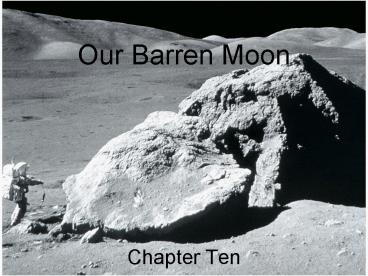Our Barren Moon - PowerPoint PPT Presentation
Title:
Our Barren Moon
Description:
Chapter Ten Introduction To Modern Astronomy I Guiding Questions Is the Moon completely covered with craters? Has there been any exploration of the Moon since the ... – PowerPoint PPT presentation
Number of Views:90
Avg rating:3.0/5.0
Title: Our Barren Moon
1
Our Barren Moon
- Chapter Ten
2
Introduction To Modern Astronomy I
ASTR 111 003
Fall 2006 Lecture 10 Nov. 06, 2006
Ch7 Comparative Planetology I Ch8 Comparative
Planetology II Ch9 The Living Earth Ch10 Our
Barren Moon Ch11 Sun-Scorched Mercury Ch12
Cloud-covered Venus Ch13 Red Planet Mars Ch14
Jupiter and Saturn Ch15 Satellites of Jup.
Saturn Ch16 Outer World Ch17 Vagabonds of Solar
System
Introducing Astronomy (chap. 1-6)
Planets and Moons (chap. 7-17)
3
Guiding Questions
- Is the Moon completely covered with craters?
- Has there been any exploration of the Moon since
the Apollo program in the 1970s? - Does the Moons interior have a similar structure
to the interior of the Earth? - How do Moon rocks compare to rocks found on the
Earth? skip 10-4 - How did the Moon form?
4
Moon Data
5
Moons Surface
- The moon has no atmosphere, because its gravity
is too small to retain any atmosphere
- The moons surface features
- Craters
- Everywhere
- Terrae (mean land)
- the light-colored area
- highlands on the Moon
- Maria (mean sea)
- the dark area
- low-lying plains
6
Moons Surface
- Craters
- Caused by impacts from space debris
- Everywhere
- no evidence of plate tectonic activity on the
Moon - Moon is too small to retain internal heat
7
Moons Surface
- Maria
- plains of remains of huge lava flow
- dark color due to the color of solidified lava
- Fewer craters on a mare than the surrounding
highlands - Hence, mare formed relatively young
- Mare basin was caused by impacts of very large
meteoroids or asteroids.
8
Manned exploration of the Moon
- From 1969 to 1972, 12 astronauts walked on the
Moon, through 6 successful manned landings - July 21, 1969, 256 UTC, Armstrong put his left
foot on the surface, and spoke - That's one small step for (a) man, one giant leap
for mankind.
9
Manned exploration of the Moon
- Much of our knowledge about the Moon has come
from human exploration and from observations by
unmanned spacecraft - About 400 kg of lunar materials have been brought
back by Apollo astronauts - Seismic equipment have been put on the Moon to
detect moonquakes and deduce the structure of the
moons interior - Mirrors have been put on the Moon to measure the
accurate Earth-Moon distance using Laser light - NASA Return to Moon plan
- Send 4 astronauts back to Moon in 2018
- Build a large scale Moon base in the next 25
years
10
Moons Internal Structure
- Like the Earth, the Moon has crust, mantle, and
core - Core is iron-rich, about 700 km in diameter
- Core is small no global magnetic field
- Moons solid lithsophere is about 800 km thick
- In contrast, the Earths lithosphere is only 50
km thick - Therefore, Moon has no plate tectonics
11
Formation of the Moon
- The collisional-ejection theory holds that
- the proto-Earth was struck by a Mars-sized
protoplanet - debris from this collision coalesced to form the
Moon
12
Formation of the Moon
- The collisional-ejection theory explains
- Low density of Moon
- Small core of Moon
- Because the Earths iron has sunk to its center
due to chemical differentiation, little iron
would have been ejected
13
Tidal Forces
- The Earths tidal force on the Moon produces the
synchronous rotation of the Moon - The Moons tidal force on the Earth slows down
the Earths rotation, through the friction
between Earth and its bulged oceans 0.002 sec
per century
14
Final Notes on Chap. 10
- There are 5 sections in total
- Section 10-4 (on Moon rocks) is not studied































